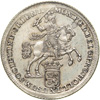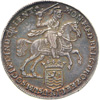
|
Sale 46
The Millennia Collection
| Lot |
Photo |
Description |
Realized |
Lot 908 |
 |
Netherlands East Indies. 8 Reales, 1601. Struck at Dordrecht for the United Amsterdam Co. Scholten-1; Dav-413; Delm-1206; Salvesen-11. Crowned arms flanked by rampant lions. Reverse: Crowned shield, rampant lion within. Superb natural and beautifully toned surfaces without any handling flaws. NGC graded MS-63.
As the European powers competed to gain economic advantage through the exploitation of overseas colonies, it became apparent that use of specific trade coinage would serve a second purpose by advertising the existence of the home nation (much as a newspaper would do in the next era). With Spain the world's leading naval power prior to 1588, the other nations were forced to act much like pirates as they tried to garner influence and wealth. After the defeat of the Spanish Armada, Great Britain produced its Portcullis coinage in December of 1600. A very few months later, the Compagnie Van Verre in Amsterdam struck a similar series of silver coins at the Dordrecht mint which were intended to emulate the Spanish real series. Those issues by mintmaster Jacol Jansz de Jonge were distributed by the famed Vereenigde Oostindische Compagnie (VOC) which became powerful shortly after being formed in 1602. Of the eleven examples of this type believed to be in private hands, no others are known in a finer state of preservation. Although not struck in a collar, this piece appears to be fully round and with minimal stress evident. The pedigree includes years in the holdings of Randolph Zander as well as the Johnson and Craig family collections.
Estimated Value $12,000 - 14,000.
Ex Irving Goodman Collection.
View details and enlarged photos
| Realized
$31,200 |
Lot 909 |
 |
Netherlands East Indies. Crown, or Real of 48 Stuivers, 1645 (Batavia). Scholten 12; Bucknill 39; Maillet, pl. xiii, 1; Catalogus Bataviaasch Genootschap 34 (this coin); Dav-415; KM-34, and p.895, this coin. 26.02 grams. Netherlands East India Company. Upright sword with filleted laurel wreath behind; BATAVIAE ANNO 1645, around. Reverse: VOC monogram, with value above, four arabesques around. Old institution number, "34," lightly inked in the obverse field at five o'clock. Deeply toned. Of the Highest Rarity! The finest of six known specimens. NGC graded EF-45.
This is the first silver dollar-sized coin minted in the Orient! To combat a local shortage of silver in the Dutch Indies, pieces having a value of 12, 24, and 48 Stuivers were cast locally to lighter standard, with the 48 Stuivers being equal in weight to seven-eighths of a Lion Daalder. These were also, the first round silver coins made anywhere in the Orient. However, they were eventually withdrawn from circulation in 1647.
During its history of nearly 200 years, the Dutch East India Company (Verenigde Oostindische Compagnie or V.O.C) became the largest company of its kind, and one of the most profitable -- trading in spices like nutmeg, cloves, cinnamon, pepper, and other scarce and coveted consumer products such as tea, silk, and Chinese porcelain, and, most importantly, coffee.
The preliminaries to the Company can be traced to the 1580's and 90's, with the incorporation of Portugal into the Hapsburg's Spanish holdings (where it would remain for sixty years). During that time, some Dutch prisoners, who had been sentenced to galley duty, wound up traveling to India aboard Portuguese ships. Later, during the Dutch revolt for independence, some of these liberated galley slaves would would prove to be of momentous importance to their fellow Dutchmen. Portugal, who had a lock on the sea trade routes to Africa and India, had treated the trading knowledge, their maps and navigation routes as state secrets. To adventurous Dutch captains, Portugal's secrets were now an open book because of these former Dutch prisoners. In 1596 four Dutch ships sailed off to Java. Within two years, twenty-two ships had sailed to the far East, with thirteen having returned loaded with spices. The profits were such as to quickly inspire other shippers to follow. Amsterdam immediately became Europe's new center for exotic, foreign goods. Within a few years the competition among their fellow traders was so intense, that prices rose and profits plummeted. The native chiefs in the East Indies were becoming rich, while the Dutch entrepreneurs were barely making ends meet. As has been seen earlier in their history, in finance and commerce the Dutch are an extremely practical people. Thus their solution for too much competition in trade was was plain and simple: put an end to competition.
So in 1602, the Dutch government had those merchants involved in the East Indies trade form a company, the Verenigde Oostindische Compagnie, allowing them the monopoly of all trade and shipping outside the Atlantic Ocean area. The V.O.C. became a huge success. It dominated the spice trade in the area, pushing out the English and Portuguese as competitors, and eventually becoming a virtual monopoly of that market. Similarly the V.O.C., from 1641 onward, also enjoyed a monopoly in the trade with Japan, again forcing out not only English and Portuguese competition, but the Spanish also. By the 17th century, the V.O.C. was the most important European company in the Asia trade.
Excerpt from Jacques Schulman letter:
Amsterdam, August 29th. 1986
"Speaking of rarety: Only 6 pieces of this coin are known:
1. In the Royal Coin Cabinet The Hague, in this collection already before 1890.
2. A museum in Rotterdam from our auction 1951 originally from the Rijnbende collection (1890).
3. Baldwin London bought a specimen in our november 1960 sale which originated from the Moquette collection, our sale May 1929. I have no record as to where this piece is at the moment.
4. The specimen from the Stephanik collection (sold in 1904). All coins of the Dutch East Indies were sold as one lot, the buyer however is unknown to us.
5. The Ran Zander specimen, the origin of which is not known to me.
6. This specimen. From the Museum of Batavia (hence the no. 34 in ink on the coin), and already listed in their catalogue of 1896!
Further "proof" of its rarety is the fact that such famous collectors as Virgill Brand and Garett never possesed this coin."
Estimated Value $70,000 - 80,000.
Ex Batavia Museum Collection (note ink #34 on obverse)
Illustrated in Money of The World, coin 110.
View details and enlarged photos
| Realized
$132,250 |
Lot 910 |
 |
Netherlands East Indies. Ducaton, 1728 (Westfriesland). Dav-419; Delmonte-1064; Scholten-40a; KM-130.1. Plain edge. Knight riding left. Reverse: Crowned crest supported by lions over "VOC" monogram. This is the first year of issue of "VOC" ducatons. Toned. Rare. NGC graded EF-40.
Such coins as these were used for the payment of Asiatic herbs and spices, especially coffee for us Westerners, coffee is three hundred years old, but in the East it was widespread as a beverage, in every level of society, since earlier times. The first definite dates go back to 800 B.C.; but already Homer, and many Arabian legends, tell the story of a mysterious black and bitter beverage with powers of stimulation. And there is a strange story, dating from 1400, of a Yemeni shepherd who, having observed some goats cropping reddish berries from a bush, and subsequently becoming restless and excited, reported the incident to a monk. The latter boiled the berries, and then distilled a bitter beverage, rich in strength, and capable of dispersing sleep and weariness. However the discovery occurred, the fact remains that the coffee plant was born in Africa in an Ethiopian region (Kaffa). From there it spread to Yemen, Arabia and Egypt, where it developed enormously, and entered popular daily life.
By the late 1500's the first traders were selling coffee in Europe, thus introducing the new beverage into Western life and custom. Most of the coffee exported to European markets came from the ports of Alexandria and Smyrna. But the increasing needs of a growing market, improved botanical knowledge of the coffee plant, and high taxes imposed at the ports of shipment, led dealers and scientists to try transplanting coffee in other countries. The Dutch in their overseas colonies (Batavia and Java), the French in 1723 in Martinique, and later on in the Antilles, and then the English, Spanish and Portuguese, started to invade the tropical belts of Asia and America.
The Dutch become the first to transport and cultivate coffee commercially. Coffee was smuggled out of the Arab port of Mocha and transported to Ceylon and East Indies for cultivation
Coffee was introduced to Indonesia by the Dutch. Legend has it that the original coffee plant which was introduced into Java, in 1696, was one of the seven highjacked coffee plants from Arabia. Java became a major coffee producing area. However, both the port of Mocha in Yemen and the island of Java in Indonesia could not ship enough coffee to supply the growing coffee demand in Europe. It should be noted that these two ports' names are how coffee got the name Java and Mocha. Anyhow, the price got so high that only those Europeans rich enough to afford exotic luxuries could drink coffee.
Estimated Value $1,000 - 1,200.
Ex Irving Goodman Collection.
View details and enlarged photos
| Realized
$2,530 |
Lot 911 |
 |
Netherlands East Indies. Ducaton, 1739 (Holland). Dav-417; Delmonte-1061 (Rarity-2); Scholten-28b; KM-71. Milled edge variety. Knight riding right. Reverse: Crowned crest supported by lions over "VOC" monogram. Softly struck near rim, lustrous. NGC graded MS-62.
Another trade coin issued for the same reasons as previous stated, this issued in Holland.
Estimated Value $1,750 - 2,000.
Ex Irving Goodman Collection.
View details and enlarged photos
| Realized
$4,255 |
Lot 912 |
 |
Netherlands East Indies. Ducaton, 1741 (Zeeland). Dav-418; Delmonte-1062 (Rarity-2); Scholten-39b; KM-151. Plain edge. Knight riding right. Reverse: Crowned crest supported by lions over "VOC" monogram. Nicely toned. Rare. NGC graded AU-55.
Same as above, the Ducaton being the standard trade coin of the area, this example struck in Zeeland.
Estimated Value $1,600 - 1,800.
Ex Irving Goodman Collection.
View details and enlarged photos
| Realized
$3,105 |
Lot 913 |
 |
Netherlands East Indies. 3 Gulden, 1786 (Gelderland). KM-54; Sch-62B; Delm-1163. Crowned crest over "VOC" monogram. Reverse: Dutch Maiden as Pallas. Lustrous. Rare in grade. NGC graded MS-62.
This coin is a different denomination, but is virtually the same weight as the Ducaton, and issued for the same reason. "VOC" was the Dutch trading company set up for commerce is the East Indies. Both coins, in terms of actual pure silver content, were nearly twenty per cent heavier than the Spanish 8 Reales also circulating in the area.
Estimated Value $1,700 - 2,000.
Ex Irving Goodman Collection.
View details and enlarged photos
| Realized
$3,565 |
|
|